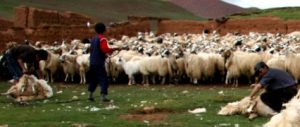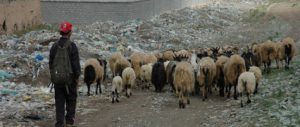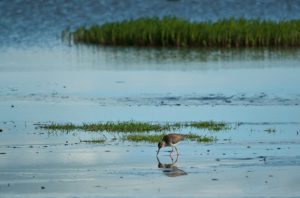Sanjiangyuan – which literally translates as the ‘three river source area’ – feeds China’s mightiest rivers. The 300,000-square kilometre region, high on western China’s Qinghai-Tibetan plateau, provides a quarter of the Yangtze’s water, almost half of the Yellow River’s and 10% of the Mekong’s.
Crucial as this area is, its environment is deteriorating, with rising snowlines, shrinking lakes, wetland degradation and reduced runoff. As early as 2001, over 90% of Qumarleb county’s wells were found to be empty, while 100 of Madoi county’s 4077 lakes had dried up.
More than half of the usable grassland is severely degraded, suffering desertification or over-run with pests.
The situation has been compounded by a sharp drop in biodiversity, both in absolute numbers and types of species. More than 100,000 Tibetan antelope – a “grade one” state protected species – used to roam the plateau. Numbers fell to just 30,000 at their ebb, though recently the population has been rising again. The alpine musk deer is on the brink of extinction, and there has been a sharp drop in the numbers of white lipped deer, red deer and snow leopards.
Ecological degradation in Sanjiangyuan is plain to see. But is it a natural disaster or a man-made one? It was with this question in mind that I set off late last year on the “Yellow River Decade Journey”, a mission to survey the region’s ecology organised by Chinese NGO Green Earth Volunteers. The trip took me from Madoi county to the Yellow River source in Qumarleb.
Believing that overgrazing of livestock is behind the ecological degradation of Sanjiangyuan, China’s government has implemented grazing bans and policies to resettle herders – so-called “ecological migration”. But were nomadic herders really the problem? Our trip to the Yellow River source conservation area to carry out this field survey finally gave us a chance to find out the truth.
Controversy over role of Tibetan herders
One faction of experts at the Chinese Academy of Sciences (CAS), concentrated within the Institute of Geographic Sciences and the Northwest Institute of Plateau Biology, back the view that overgrazing is the cause of the problems. But other CAS researchers say different. Professor Liu Shiyin of the Cold and Arid Regions Environmental and Engineering Research Institute argues that climate change is the root cause of the vicious cycle of ecological degradation.
In the last 50 years, the region’s average annual temperature has increased by 0.88℃. In the last 30 years, glacier coverage has decreased by 17%, and the average rate at which glaciers have been shrinking has been 10 times faster than it was 300 years ago.
Ma Liangjun, head of Qinghai province’s Soil and Water Conservation Monitoring Station, believes that natural causes are the key drivers of Sanjiangyuan’s ecological deterioration, but says rampant human development has compounded the area’s fragility.
Because of the grazing ban, the grassland we saw on our journey was for the most part empty and desolate – save for some wild animals. We rarely saw grazing livestock.
“This is decent pasture. Not allowing herders to graze their animals on it really is a huge waste,” said Zhao Lianshi of the China Association for the Scientific Expedition of Exotic and Rare Animals, one of my fellow travellers. In Zhao’s opinion, grazing and trampling doesn’t harm or destroy the grassland – it actually contributes to its healthy development.
The numbers don’t add up either. Just 120,000 head of livestock are kept by herders in the whole of Madoi county, according to Duo Huaben, deputy minister of Madoi county’s agriculture bureau, “But the entire pasture area can sustain three million.” Even if you add in the number of wild herbivores, there are still only 200,000-odd animals grazing in the area.
Local records show that, in 1974, Qumarleb county’s livestock herd numbers surpassed one million. But in 1985, a major snowstorm swept across Qinghai, wiping out half the county’s livestock. Ten years later, another storm dealt the industry a second heavy blow. To date, provincial livestock numbers have not recovered to those of 1985 and the county only has 490,000 livestock today.
Gold mining and climate change the real culprits
Overgrazing was more intense before the 1980s, so why has ecological degradation been so severe in the decades since – a time when livestock numbers have fallen significantly?
A report from Qinghai province’s Academy of Social Sciences argues that the banned practices of digging for caterpillar fungus, bulbous plants and the rhodiola herb – which continue today – plus large-scale gold mining are the major human cause of grassland degradation. Environmental geologist and explorer Yang Yong agrees: “You can’t blame it all on the herdsmen. Since 1949 there have been many instances of government movements which have been ecologically damaging, the negative effects of which still exist.”
It is clear that forcing herders to give up their nomadic way of life will not revive the Yellow River source area in the way people hope. During our trip, we drove along a road of dirt, sand and stone, which ran along a river valley covered in sand and stones. It was obvious that this valley was in a fairly serious state of desertification.
At another spot, Huang Yusheng, an expert in environmental impact assessments for dams who was travelling in our group, pointed at a patch of grassland on the roadside, saying: “Although on the surface this patch looks like a layer of grass, the sand beneath will slowly start to show through. It won’t be many more years before this grassy area has turned to desert too.”
The desertification of grassland is happening – that’s a fact. But herders aren’t the problem. “In reality global climate change is the real culprit behind the ecological changes in Sanyuanjiang,” explains Wang Yongchen, founder of Green Earth Volunteers.
Although it was already early winter, in many places along the road we could still see meadows filled with strong yellow tones mixed in with gentler greens. Duo Huaben explained that the previous year the weather was very dry and the pastures didn’t grow too well. But in 2012 there was plenty of rain, giving much more vitality to the landscape. Rainfall is the force which determines the fate of alpine meadows.
We also saw some unexpectedly heavy snow, which in a matter of moments had covered the grassland in a layer of white. The snow cover soon melted, however, and through various capillary-like lakes and streams of different sizes, was transported back to the Yellow River.
Fluctuations in the amount of water at the Yellow River source are closely connected to climate change. Any abnormal climatic changes impact the amount of rain brought here. This has a direct effect on the grassland. If rainfall is high one year, grassland vegetation will grow well, but too little rainfall will cause a decline, directly affecting animals that rely on the grasslands.
Herders forced to abandon traditional way of life
Banning grazing and making local herdsmen abandon their nomadic ways or move away creates new problems. Duo Huaben explains how, for more than a decade, herdsmen have been migrating to settlements and given 8,000 yuan annually by the state.
These herdsmen leave the grasslands which nurtured their ancestors and abandon their traditional way of life in order to move to town and city settlements. But they aren’t always able to get a grip on the new way of doing things. Some struggle to make money, while state subsidies are too small to survive on. But they have no other options.
Sanjiangyuan’s ecological degradation is a complicated natural and man-made process. Simply banning herding will not fix the problem. Worse, the ban may boost numbers of animals like rabbits and wild donkeys, which lack sufficient natural predator controls. This could lead to rapid population growth, causing new ecological imbalances.
Human interventions like the grazing ban might promote the recovery of original habitats in the short term, but are not a long-term solution. Only by respecting and relying on nature will humans and the natural world finally manage to co-exist in harmony.



